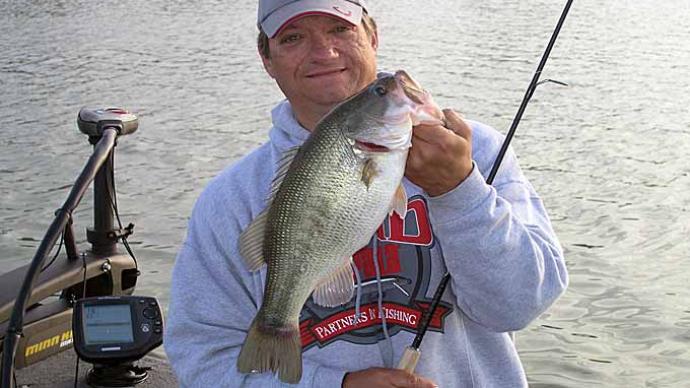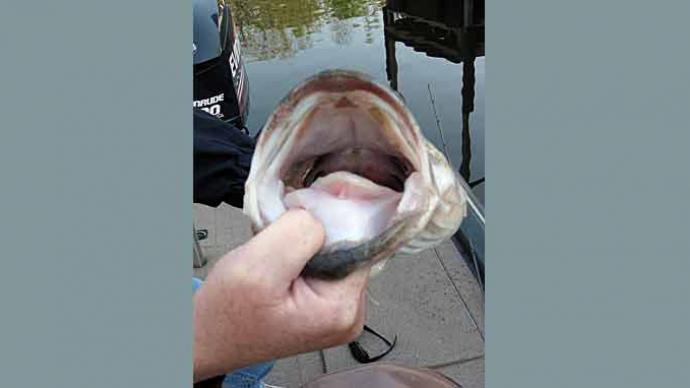
The first time I saw the potential of deepwater cranking was at a 1993 BASS Top 100 tournament, where I got drawn to fish as an amateur. On the third day of the tournament, I was paired with David Fritts.
That day we fished the ends of slow tapering points in about 15 feet of water. He was throwing a crankbait, and I chose to throw a Carolina rig. And although we were both throwing "search" type baits, he consistently drew more strikes. It was then I saw the actual quality of deep-cranking. He was able to effectively search deep water and elicit a deflection or reaction bite simultaneously.
I consider deep-water cranking to be anything deeper than 10 feet. My most normal range for deep-cranking would be anywhere from 12- to 20-feet. Getting deeper than 20 gets to be a chore.
The reason this technique is so good is simple. It is underutilized. Not that many people feel comfortable throwing a diving plug in water deeper than 10 feet.
One of the most significant mental concepts that I came up with to help me get over that "deep" mental block is to compare the bottom depth with the length of my boat. When fishing a breakline in 18 feet of water, look back at your boat. Most bass boats are about 18 feet long. That's not that deep. It helps put your fishing into perspective.
A Search Tool
After that day with Fritts, I began to take notice of the deep-diving crankbait as a search tool. It allows you to cover vast amounts of water and gives you the ability to read the bottom. That's key.
With a crankbait hitting bottom, I can feel where a mud bottom turns to rock or can bump that lone brush pile on the end of a point. Your crankbait is acting not only as a fish catcher but also as a depth and bottom type finder. Using a deep-diving crankbait with your electronics helps you find those natural isolated hot spots.
The Deflection Factor
Like shallow water cranking, the deflection factor is critical in catching about 90% of the fish. Your crankbait must change direction or speed to elicit a strike except cranking through suspended fish. I make a conscious effort to cause that bait to change direction (deflect).
The most obvious way is to bounce off some form of cover. The ability for a crankbait to crash and bounce off of cover and trigger that inactive, reaction-type strike is uncanny.
Even when the bait is running in open water or hitting clean bottom areas, I use techniques to cause that bait to change movement. Changing speeds is my most effective method. Also, throwing a jerk or pause into the retrieve will have the same effect.
Line Size and Long Casts
The use of line size and casting distance are two of the most critical factors in deep cranking. On average, expect about a foot and a half depth change with every line size change. The heavier the line, the shallower the crankbait will run. The lighter the line, the deeper the crankbait will run.
Knowing this, you can use line size to determine and fine-tune the running depth of your baits. A lighter line like an 8-10 pound test can help a bait achieve maximum death.
Casting length also helps achieve the maximum running depth of a crankbait. When deep-cranking, I always try to make the longest possible cast. But I always keep a reference on where I want that bait to hit. I try and keep my designated target a little less than halfway back to the boat. This means you should always over-shoot your intended target when deep-cranking.
Rod Positioning
This is also a critical factor in achieving the desired depth. The lower the position of the rod, the deeper a crankbait will ride. The higher the rod tip, the shallower it will dive.
In general, when deep-cranking, I try to keep the rod tip's low angle in about the 4 or 5 o 'clock position. It's almost like you'll lean the rod on your leg. Besides gaining maximum depth, this low rod position will aid in the slight delay in the hook-set needed with crankbaits.
When anything out of the ordinary is detected (pressure, the line goes slack, stop feeling the vibration), I either start to sweep up or to the side. If it is a fish, I continue through with the sweep motion. If it's not a fish and is a stump, I bring the rod immediately back down to its original position.
As the crankbait gets closer to the boat, I will begin to slowly raise my rod tip until the bait is directly under the boat and the rod is in the 3 o'clock position.
Use rod positioning to your advantage. Play with the positioning of your rod to achieve the perfect running depth. Also, for incredibly depth conditions, consider the kneel and reel technique. It does work!
Retrieve Speed
This depends upon the conditions. But as a general rule, I use a medium-fast retrieve until the bait has hit its desired depth zone. I then bump down to a straight medium retrieve, occasionally slowing the bait down if I come in contact with cover.
More than anything, let the fish's water temperature and activity mood determine your retrieve speed. (colder/less active= slower, warmer,more active=faster).
Tackle and Equipment
I select crankbaits on the same principles established earlier. I am choosing an action and color based on conditions. Some of the ones I use include Mann's Plus Series, Normand N's, Fat-Free Shads, and Risto Raps.
I generally use the range closest or deeper than the water I will be fishing. For example: if I were to fish a hump in 13 feet of water, I would choose the Mann's 15 Plus.
I want to achieve the delay concept in my rods. I am looking for a rod with a soft, flexible tip, which will do three things. First, it will delay the hook set just slightly, which is what you want with a crankbait. Second, it will allow me to land more fish with these treble hooked lures. When the fish surges next to the boat, the rod will give with the surge, and the hooks will not pull out. And third, the soft tip will allow me to load up the rod on the cast, thereby achieving maximum casting distance.
I use a cranking rod in a 7' length. This rod is a fiberglass and graphite mix. I specifically use the 7' rod to achieve maximum casting distance.
I use a medium ratio reel, not the super slow ratios you've read about for years. I like to have the option to reel fast or slow. I also need a reel with a large spool capacity (for long cast) and a tremendous anti-reverse system.
I most often use line sizes ranging from 8 to 14lb. test.
I use Suspend Strips when I want to get a suspending type of lure. I use them in conjunction with bigger hook replacements. I probably do this more in the early spring and the heat of the summer more than any other time.




